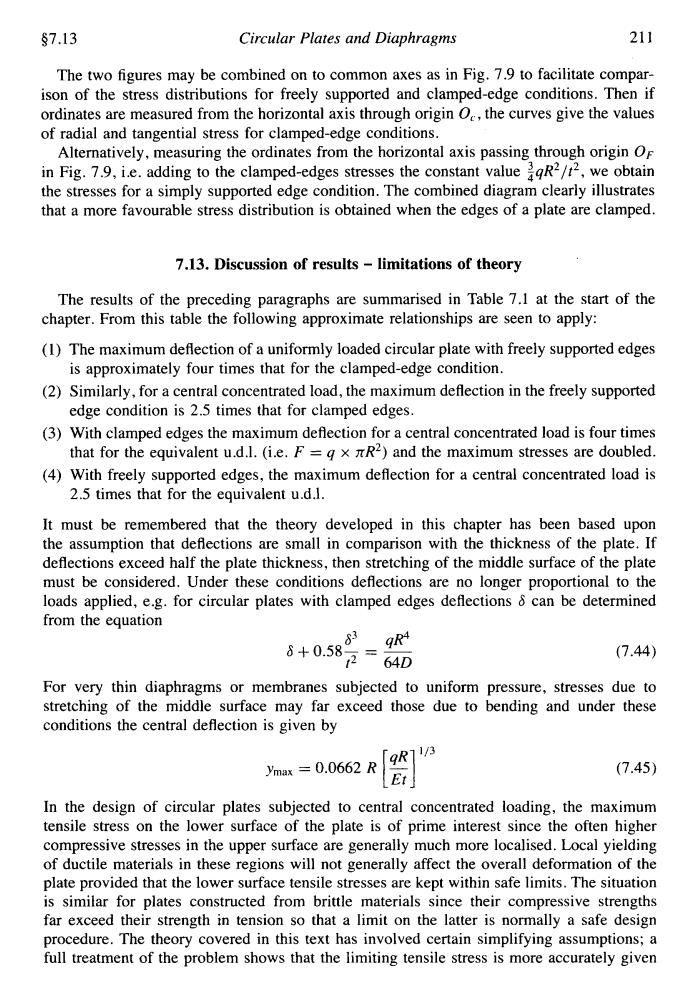正在加载图片...

§7.13 Circular Plates and Diaphragms 211 The two figures may be combined on to common axes as in Fig.7.9 to facilitate compar- ison of the stress distributions for freely supported and clamped-edge conditions.Then if ordinates are measured from the horizontal axis through origin O,the curves give the values of radial and tangential stress for clamped-edge conditions. Alternatively,measuring the ordinates from the horizontal axis passing through origin OF in Fig.7.9,i.e.adding to the clamped-edges stresses the constant valueR2/12,we obtain the stresses for a simply supported edge condition.The combined diagram clearly illustrates that a more favourable stress distribution is obtained when the edges of a plate are clamped. 7.13.Discussion of results -limitations of theory The results of the preceding paragraphs are summarised in Table 7.1 at the start of the chapter.From this table the following approximate relationships are seen to apply: (1)The maximum deflection of a uniformly loaded circular plate with freely supported edges is approximately four times that for the clamped-edge condition. (2)Similarly,for a central concentrated load,the maximum deflection in the freely supported edge condition is 2.5 times that for clamped edges. (3)With clamped edges the maximum deflection for a central concentrated load is four times that for the equivalent u.d.I.(i.e.F=g x R2)and the maximum stresses are doubled. (4)With freely supported edges,the maximum deflection for a central concentrated load is 2.5 times that for the equivalent u.d.I. It must be remembered that the theory developed in this chapter has been based upon the assumption that deflections are small in comparison with the thickness of the plate.If deflections exceed half the plate thickness,then stretching of the middle surface of the plate must be considered.Under these conditions deflections are no longer proportional to the loads applied,e.g.for circular plates with clamped edges deflections 8 can be determined from the equation 83qR4 8+0.587= (7.44) 64D For very thin diaphragms or membranes subjected to uniform pressure,stresses due to stretching of the middle surface may far exceed those due to bending and under these conditions the central deflection is given by 9R7/3 ymax =0.0662 R (7.45) Et In the design of circular plates subjected to central concentrated loading,the maximum tensile stress on the lower surface of the plate is of prime interest since the often higher compressive stresses in the upper surface are generally much more localised.Local yielding of ductile materials in these regions will not generally affect the overall deformation of the plate provided that the lower surface tensile stresses are kept within safe limits.The situation is similar for plates constructed from brittle materials since their compressive strengths far exceed their strength in tension so that a limit on the latter is normally a safe design procedure.The theory covered in this text has involved certain simplifying assumptions;a full treatment of the problem shows that the limiting tensile stress is more accurately given$7.13 Circular Plates and Diaphragms 21 1 The two figures may be combined on to common axes as in Fig. 7.9 to facilitate comparison of the stress distributions for freely supported and clamped-edge conditions. Then if ordinates are measured from the horizontal axis through origin 0,. , the curves give the values of radial and tangential stress for clamped-edge conditions. Alternatively, measuring the ordinates from the horizontal axis passing through origin OF in Fig. 7.9, i.e. adding to the clamped-edges stresses the constant value aqR2/t2, we obtain the stresses for a simply supported edge condition. The combined diagram clearly illustrates that a more favourable stress distribution is obtained when the edges of a plate are clamped. 7.13. Discussion of results - limitations of theory The results of the preceding paragraphs are summarised in Table 7.1 at the start of the chapter. From this table the following approximate relationships are seen to apply: The maximum deflection of a uniformly loaded circular plate with freely supported edges is approximately four times that for the clamped-edge condition. Similarly, for a central concentrated load, the maximum deflection in the freely supported edge condition is 2.5 times that for clamped edges. With clamped edges the maximum deflection for a central concentrated load is four times that for the equivalent u.d.1. (i.e. F = q x nR2) and the maximum stresses are doubled. With freely supported edges, the maximum deflection for a central concentrated load is 2.5 times that for the equivalent u.d.1. It must be remembered that the theory developed in this chapter has been based upon the assumption that deflections are small in comparison with the thickness of the plate. If deflections exceed half the plate thickness, then stretching of the middle surface of the plate must be considered. Under these conditions deflections are no longer proportional to the loads applied, e.g. for circular plates with clamped edges deflections 6 can be determined from the equation 63 qR4 t2 640 6 + 0.58- = - (7.44) For very thin diaphragms or membranes subjected to uniform pressure, stresses due to stretching of the middle surface may far exceed those due to bending and under these conditions the central deflection is given by (7.45) In the design of circular plates subjected to central concentrated loading, the maximum tensile stress on the lower surface of the plate is of prime interest since the often higher compressive stresses in the upper surface are generally much more localised. Local yielding of ductile materials in these regions will not generally affect the overall deformation of the plate provided that the lower surface tensile stresses are kept within safe limits. The situation is similar for plates constructed from brittle materials since their compressive strengths far exceed their strength in tension so that a limit on the latter is normally a safe design procedure. The theory covered in this text has involved certain simplifying assumptions; a full treatment of the problem shows that the limiting tensile stress is more accurately given